 About twenty years ago, Texas lawmakers approved a per se DWI law. Before the legal change, a BAC level above the legal limit was a presumption of intoxication. Now, people with a BAC over the limit may be intoxicated as a matter of law. Not surprisingly, the DWI conviction rate increased significantly.
About twenty years ago, Texas lawmakers approved a per se DWI law. Before the legal change, a BAC level above the legal limit was a presumption of intoxication. Now, people with a BAC over the limit may be intoxicated as a matter of law. Not surprisingly, the DWI conviction rate increased significantly.
Yet despite the per se law, the Field Sobriety Tests are still important. They serve as probable cause for the sample request. If the defendant refuses to provide a sample, the FSTs are the primary evidence of guilt or innocence at trial. Either way, a Weatherford criminal defense attorney must be able to attack the FST results.
Approved Tests
Scientists say that intoxicated people cannot coordinate physical activity and the thought process. So, the two firmly-established FSTs are both divided attention tests. They are both flawed.
First, there is the one leg stand. Defendants must elevate one leg for about ten seconds. Any mobility impairment makes this test almost impossible to perform. And, a Parker County prosecutor must prove that the defendant failed the one leg stand because s/he was intoxicated, and not because s/he was sleepy, disabled, injured, or clumsy.
In the walking a straight line test, or heel to toe walk test, the defendant must walk a straight line heel to toe forward and backward. Even a slightly uneven surface makes this test difficult to perform. That’s especially true if conditions are poor, like a dark sky. Furthermore, it is almost impossible to walk an imaginary line heel to toe.
Semi-Approved Tests
The horizontal gaze nystagmus test, or DWI eye test, is technically an approved FST. However, it is not a divided attention test. And, its scientific basis is rather shaky.
Test subjects must follow fixed points with their eyes without moving their heads. That fixed point is usually a fingertip or a writing pen. If the subject’s pupils move involuntarily at certain angles, the subject probably has nystagmus. So, this test has little or nothing to do with balance, coordination, or following instructions.
Furthermore, intoxication is not the only nystagmus cause. It is not even the leading cause. In fact, many people have nystagmus, which is also called lazy eye, but since the symptoms are so mild, they do not know it.
For all these reasons, an increasing number of judges only admit HGN test results into evidence for limited purposes, such as establishing probable cause.
Unapproved Tests
Some police officers administer tests they know have no scientific basis, but they administer them anyway. Some examples include the reciting the ABCs test or a balance test known as the Rhomberg test.
Sometimes, it’s for a defense attorney to argue the tests should be excluded. Other times, it’s better to let the officers testify about these unapproved tests. For example, the Rhomberg test is so complex that many officers cannot explain it to the jury. That failure makes the tests appear rigged.
Most DWI field tests are inherently weak. For a free consultation with an experienced criminal defense attorney in Fort Worth, contact Herreth Law. Convenient payment plans are available.

